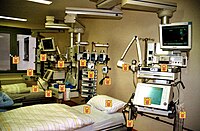
Photo from wikipedia
Abstract Aim To develop an instrument to investigate knowledge and predictive factors of needlestick and sharps injuries (NSIs) in nursing students during clinical placements. Design Instrument development and cross‐sectional study… Click to show full abstract
Abstract Aim To develop an instrument to investigate knowledge and predictive factors of needlestick and sharps injuries (NSIs) in nursing students during clinical placements. Design Instrument development and cross‐sectional study for psychometric testing. Methods A self‐administered instrument including demographic data, injury epidemiology and predictive factors of NSIs was developed between October 2018–January 2019. Content validity was assessed by a panel of experts. The instrument's factor structure and discriminant validity were explored using principal components analysis. The STROBE guidelines were followed. Results Evidence of content validity was found (S‐CVI 0.75; I‐CVI 0.50–1.00). A three‐factor structure was shown by exploratory factor analysis. Of the 238 participants, 39% had been injured at least once, of which 67.3% in the second year. Higher perceptions of “personal exposure” (4.06, SD 3.78) were reported by third‐year students. Higher scores for “perceived benefits” of preventive behaviours (13.6, SD 1.46) were reported by second‐year students.
Journal Title: Nursing Open
Year Published: 2020
Link to full text (if available)
Share on Social Media: Sign Up to like & get
recommendations!